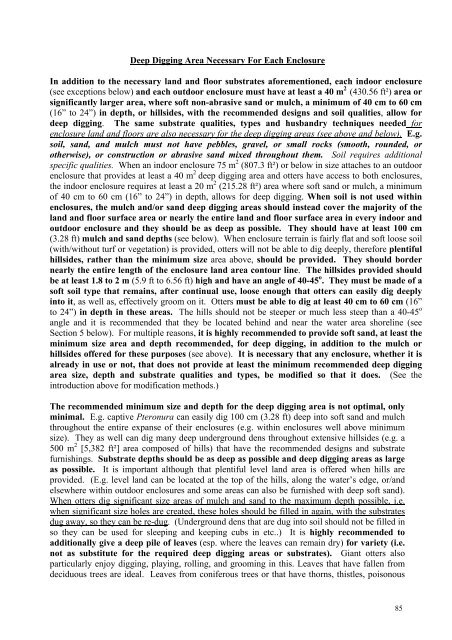International Giant Otter Studbook Husbandry and Management
International Giant Otter Studbook Husbandry and Management
International Giant Otter Studbook Husbandry and Management
You also want an ePaper? Increase the reach of your titles
YUMPU automatically turns print PDFs into web optimized ePapers that Google loves.
Deep Digging Area Necessary For Each Enclosure<br />
In addition to the necessary l<strong>and</strong> <strong>and</strong> floor substrates aforementioned, each indoor enclosure<br />
(see exceptions below) <strong>and</strong> each outdoor enclosure must have at least a 40 m 2 (430.56 ft²) area or<br />
significantly larger area, where soft non-abrasive s<strong>and</strong> or mulch, a minimum of 40 cm to 60 cm<br />
(16” to 24”) in depth, or hillsides, with the recommended designs <strong>and</strong> soil qualities, allow for<br />
deep digging. The same substrate qualities, types <strong>and</strong> husb<strong>and</strong>ry techniques needed for<br />
enclosure l<strong>and</strong> <strong>and</strong> floors are also necessary for the deep digging areas (see above <strong>and</strong> below). E.g.<br />
soil, s<strong>and</strong>, <strong>and</strong> mulch must not have pebbles, gravel, or small rocks (smooth, rounded, or<br />
otherwise), or construction or abrasive s<strong>and</strong> mixed throughout them. Soil requires additional<br />
specific qualities. When an indoor enclosure 75 m 2 (807.3 ft²) or below in size attaches to an outdoor<br />
enclosure that provides at least a 40 m 2 deep digging area <strong>and</strong> otters have access to both enclosures,<br />
the indoor enclosure requires at least a 20 m 2 (215.28 ft²) area where soft s<strong>and</strong> or mulch, a minimum<br />
of 40 cm to 60 cm (16” to 24”) in depth, allows for deep digging. When soil is not used within<br />
enclosures, the mulch <strong>and</strong>/or s<strong>and</strong> deep digging areas should instead cover the majority of the<br />
l<strong>and</strong> <strong>and</strong> floor surface area or nearly the entire l<strong>and</strong> <strong>and</strong> floor surface area in every indoor <strong>and</strong><br />
outdoor enclosure <strong>and</strong> they should be as deep as possible. They should have at least 100 cm<br />
(3.28 ft) mulch <strong>and</strong> s<strong>and</strong> depths (see below). When enclosure terrain is fairly flat <strong>and</strong> soft loose soil<br />
(with/without turf or vegetation) is provided, otters will not be able to dig deeply, therefore plentiful<br />
hillsides, rather than the minimum size area above, should be provided. They should border<br />
nearly the entire length of the enclosure l<strong>and</strong> area contour line. The hillsides provided should<br />
be at least 1.8 to 2 m (5.9 ft to 6.56 ft) high <strong>and</strong> have an angle of 40-45 o . They must be made of a<br />
soft soil type that remains, after continual use, loose enough that otters can easily dig deeply<br />
into it, as well as, effectively groom on it. <strong>Otter</strong>s must be able to dig at least 40 cm to 60 cm (16”<br />
to 24”) in depth in these areas. The hills should not be steeper or much less steep than a 40-45 o<br />
angle <strong>and</strong> it is recommended that they be located behind <strong>and</strong> near the water area shoreline (see<br />
Section 5 below). For multiple reasons, it is highly recommended to provide soft s<strong>and</strong>, at least the<br />
minimum size area <strong>and</strong> depth recommended, for deep digging, in addition to the mulch or<br />
hillsides offered for these purposes (see above). It is necessary that any enclosure, whether it is<br />
already in use or not, that does not provide at least the minimum recommended deep digging<br />
area size, depth <strong>and</strong> substrate qualities <strong>and</strong> types, be modified so that it does. (See the<br />
introduction above for modification methods.)<br />
The recommended minimum size <strong>and</strong> depth for the deep digging area is not optimal, only<br />
minimal. E.g. captive Pteronura can easily dig 100 cm (3.28 ft) deep into soft s<strong>and</strong> <strong>and</strong> mulch<br />
throughout the entire expanse of their enclosures (e.g. within enclosures well above minimum<br />
size). They as well can dig many deep underground dens throughout extensive hillsides (e.g. a<br />
500 m 2 [5,382 ft²] area composed of hills) that have the recommended designs <strong>and</strong> substrate<br />
furnishings. Substrate depths should be as deep as possible <strong>and</strong> deep digging areas as large<br />
as possible. It is important although that plentiful level l<strong>and</strong> area is offered when hills are<br />
provided. (E.g. level l<strong>and</strong> can be located at the top of the hills, along the water’s edge, or/<strong>and</strong><br />
elsewhere within outdoor enclosures <strong>and</strong> some areas can also be furnished with deep soft s<strong>and</strong>).<br />
When otters dig significant size areas of mulch <strong>and</strong> s<strong>and</strong> to the maximum depth possible, i.e.<br />
when significant size holes are created, these holes should be filled in again, with the substrates<br />
dug away, so they can be re-dug. (Underground dens that are dug into soil should not be filled in<br />
so they can be used for sleeping <strong>and</strong> keeping cubs in etc..) It is highly recommended to<br />
additionally give a deep pile of leaves (esp. where the leaves can remain dry) for variety (i.e.<br />
not as substitute for the required deep digging areas or substrates). <strong>Giant</strong> otters also<br />
particularly enjoy digging, playing, rolling, <strong>and</strong> grooming in this. Leaves that have fallen from<br />
deciduous trees are ideal. Leaves from coniferous trees or that have thorns, thistles, poisonous<br />
85

















